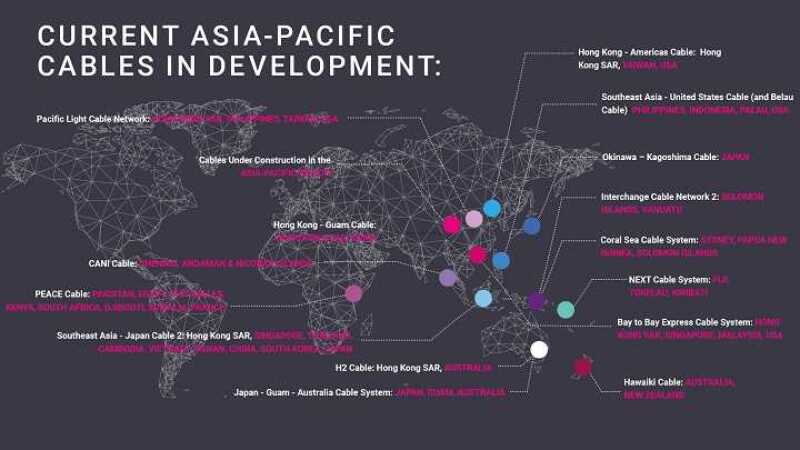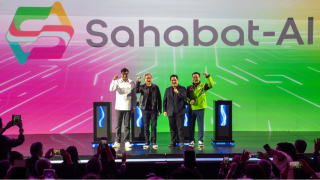Asia is riding a wave of activity in submarine development. Hong Kong SAR alone will see six new cable landing on its shores in the near future. There is also a raft of other cable developments in APAC, coincided with the emergence of new technologies and business models, all of which are facilitating increasing diversity of routes and improved latency.

Pacific Light Cable Network
Co-built by Google, Facebook and Pacific Light Data Communication, the 12,800km system will directly connect Hog Kong and the US. It will feature 6 fibre pairs, with 240 channels of 100Gbps in a single fibre pair. It has also been designed with the state-of-the-air C+L band optical technology and open cable structure.
CANI Cable
The ‘Chennai Andaman Nicobar Island’ (CANI) cable is a 2,199km system that will connect Chennai and the Andaman & Nicobar Islands. To be build by NEC it will offer speeds of 100Gbps landing at beach manhold (BMH) locations and then taken to the cable landing station (CLS) for distribution.
Hong Kong – Guam Cable (HK-2)
Due for installation and RFS in January 2020, this 3,900km cable system is owned by a consortium of Google and RTI Connectivity. The system will land in China and Guam and with speeds of 48Tbps it is another NEC build.
PEACE Cable
A 12,000km cable that will connect three continents, the PEACE Cable is described as a carriers cable owned and operated by Hengtong Group, with landing party agreements with the likes of PCCW Global and Orange. It is a 16Tbs per fibre pair system using the latest 200G and WSS technology due to RFS in Q1 of 2020.
Southeast Asia–Japan 2 Cable
The consortium behind the Southeast Asia–Japan 2 cable consists of China Mobile International, Chunghwa Telecom, Chuan Wei, Facebook, KDDI, Singtel, SK Broadband, and VNPT. The 144Tbps, 10,500km system will have 11 landing stations -- located in Singapore, Thailand, Cambodia, Vietnam, Hong Kong, China, and South Korea, with a pair of landings in Taiwan and Japan.
H2 Cable
The H2 subsea cable system will be the first direct subsea cable between Sydney and Hong Kong (9,200km), with an additional branch to Los Angeles (12,500km). The Sydney to Hong Kong branch will offer 15Tbps per fibre pair while the Sydney to Los Angeles branch will deliver more than 12.9Tbps per fibre pair.
Japan – Guam – Australia Cable
Comprised of a consortium of RTI Connectivity, AARNet and Google, together with Alcatel Submarine Networks, part of Nokia, and NEC Corporation, this 9,500km system has been designed with a capacity of 36Tbps and is due to completion in Q4 of 2019.
Hong Kong-America Cable
The Hong Kong-America Cable System is a 6-fibre-pair submarine cable connecting Hong Kong and the US directly, with initial design capacity of 12.8Tbps per fibre pair (for a total of 76.8Tbps) using 100Gbps coherent DWDM technology.
Southeast Asia – US Cable
Formed via the SEA-US cable that went live in 2017, the Palau Spur subsea cable connects the republic of Palau with Guam, with added onward connectivity to the US. With an initial design capacity of 500 Gbps, forms part of the larger 14,500km system.
Okinawa – Kagoshima Cable
Owned by the Okinawa Cellular Telephone Company, this 760km cable will connect Nago City, Okinawa Prefecture, and Hioki City, Kagoshima Prefecture. It will the latest optical wavelength multiplex transmission method and the maximum design transmission capacity is 80Tbps.
Interchange Cable Network 2
Interchange Cable Network 2 (ICN2) will be installed and ready for service around Q4 2019. With a length of 1,632km it will offer 20Gbps of capacity using SL14-A1 cables and Ciena Submarine Line Terminating Equipment.
Coral Sea Cable System
Connecting Sydney, Port Moresby and Honiara, this 4,700km system will offer 40Tbps of capacity, while at the same time delivering much needed connectivity to the people of Papua New Guinea and the Soloman Islands.
NEXT Cable System
To be built by ASN this 13,700km cable will have landing Australia, Samoa. Kiribati, the US, Tokelau, Fiji and New Zealand. Owned by a consortium of Spark New Zealand, Singtel Optus, Verizon and Telstra. It will offer 72Tbps of transmission capacity.
Bay to Bay Express
Owned by China Mobile International, Facebook and Amazon Web Services the 16,000km Bay to Bay Express cable is expected to be completed by Q4 2020. Once in service it will enable high capacity transmission of data across the Pacific Ocean with round trip latency of less than 130 milliseconds.
Hawaiki Cable
A 15,00km cable connecting Australia, New Zealand, American Samoa, Hawaii and continental US. The system has branch nunits in place to connect the Pacific Islands of New Caledonia, Fiji and Tonga. It also offers 1Gb, 10Gb and 100Gb, 200G and 250G wavelengths.






